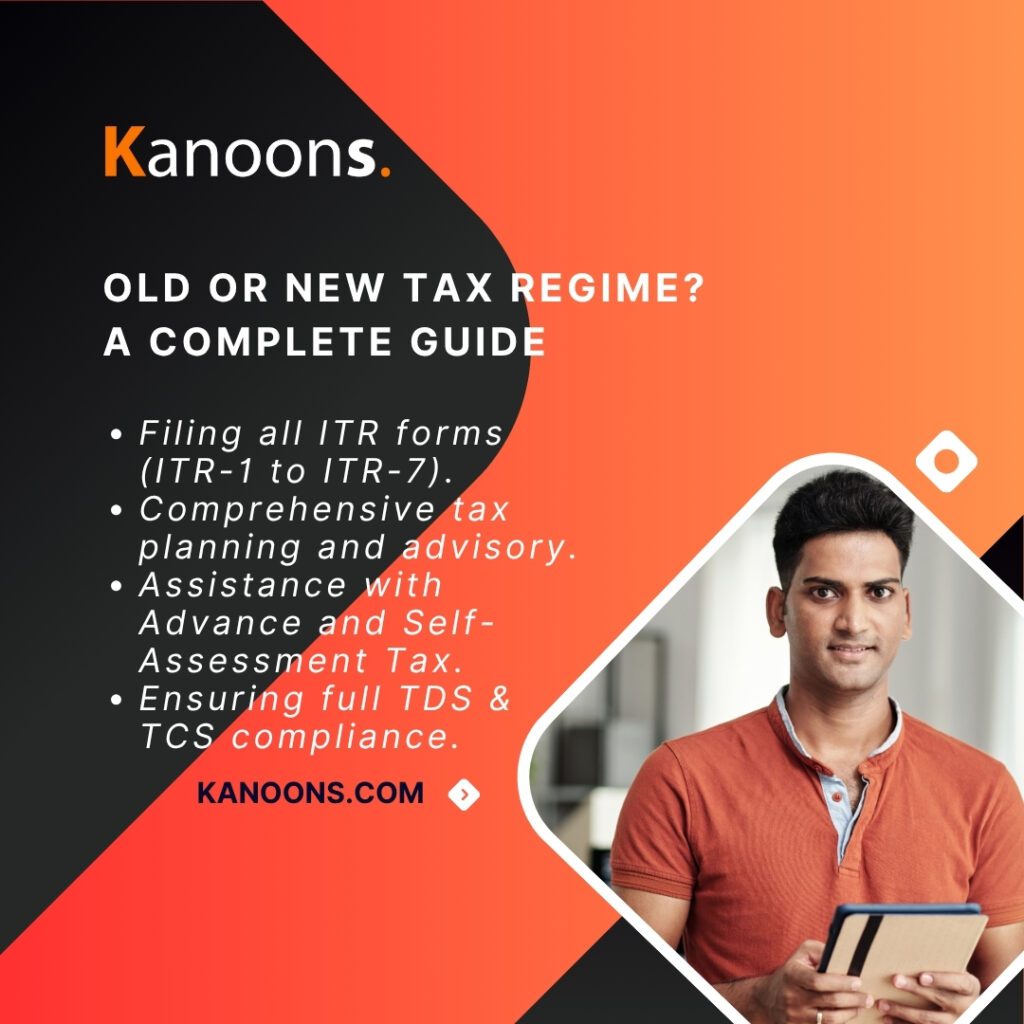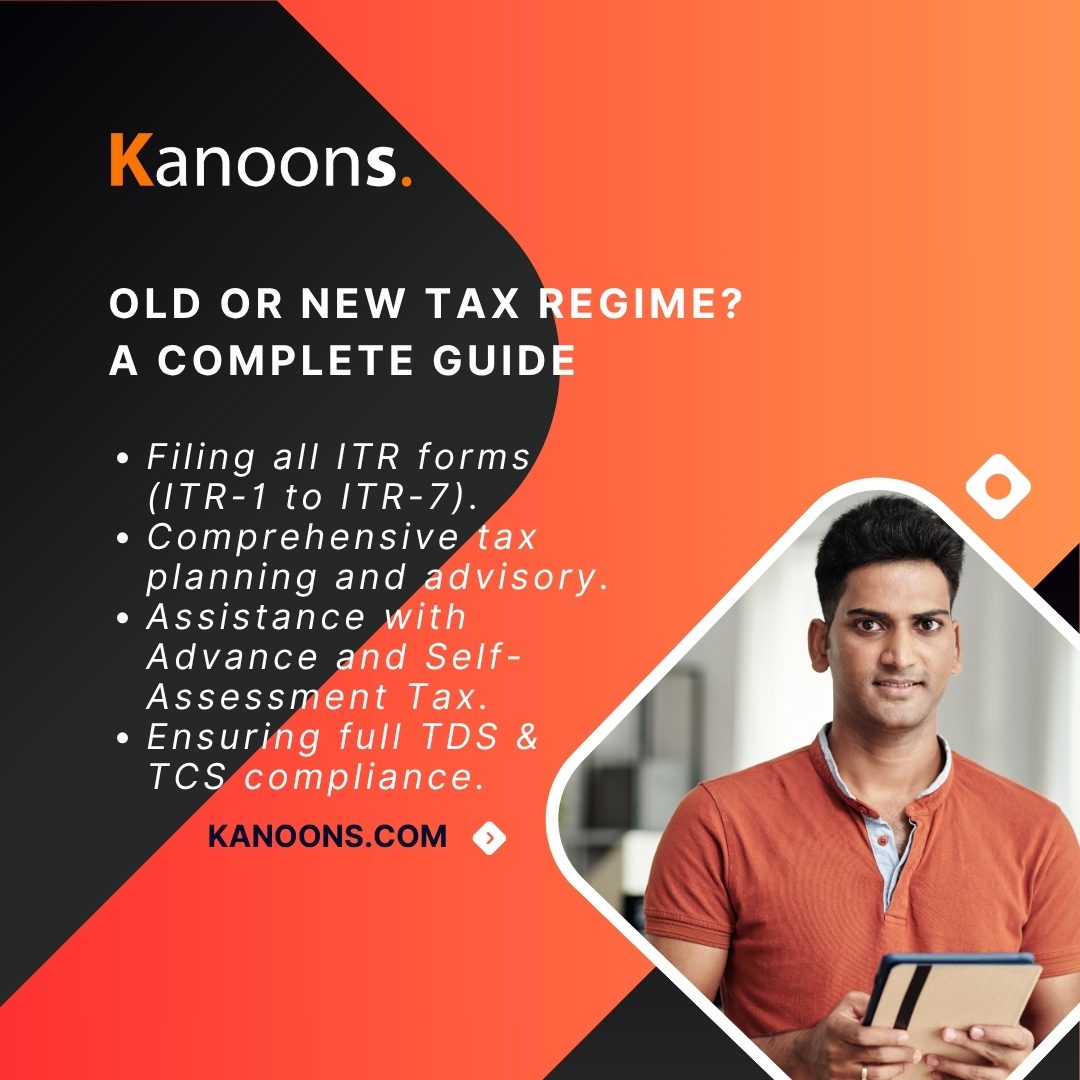The Big Question: Old or New Tax Regime? A Complete Guide for Indian Taxpayers (FY 2025-26)

The Big Question: Old or New Tax Regime? A Complete Guide for Indian Taxpayers (FY 2025-26)
Making the wrong choice could cost you a significant amount in tax.
This tax season, the single most important decision for every Indian taxpayer is choosing the right tax regime. With the new tax regime now the default, many are left wondering: should I stick with the simpler, lower-rate new regime, or is the old regime, with its valuable deductions, still the better option for me?
Making the wrong choice could cost you a significant amount in tax. This complete guide will break down both regimes, compare them side-by-side, and give you a clear framework for making the right decision for the FY 2025-26.
Understanding the Two Regimes
1. The New Tax Regime (Default)
Introduced to simplify the tax structure, the new regime operates on a “lower tax rate, no exemptions” principle. It is now the default option, which means if you don’t actively choose the old regime, your taxes will be calculated under these rules.
Key Features:
- Lower Tax Rates: The new regime has more tax slabs with generally lower rates.
- Minimal Exemptions: It disallows most common exemptions and deductions, such as those under Section 80C, 80D, HRA, and LTA.
- Standard Deduction: A standard deduction of ₹75,000 is available for salaried individuals and pensioners.
- Higher Rebate: A significant tax rebate under Section 87A makes income up to ₹12 lakh effectively tax-free.
2. The Old Tax Regime
The familiar “old” regime is based on the principle of “higher tax rates, but with many exemptions and deductions.” It encourages tax-saving investments and expenses.
Key Features:
- Higher Tax Rates: The slab rates are higher, with a 20% tax rate starting at ₹5 lakh and the highest rate of 30% starting at ₹10 lakh.
- Extensive Deductions: It allows a wide range of deductions and exemptions, which can substantially reduce your taxable income.
Old vs. New: A Side-by-Side Comparison
To help you decide, here is a detailed breakdown of the two regimes for the Financial Year 2025-26 (Assessment Year 2026-27).
| Feature | Old Tax Regime | New Tax Regime (Default) |
|---|---|---|
| Basic Exemption Limit | Up to ₹2.5 lakh (for individuals below 60) | Up to ₹4 lakh |
| Tax Slabs | ₹2.5L-₹5L: 5% ₹5L-₹10L: 20% > ₹10L: 30% | ₹4L-₹8L: 5% ₹8L-₹12L: 10% ₹12L-₹16L: 15% ₹16L-₹20L: 20% > ₹20L: 30% |
| Standard Deduction | ₹50,000 for salaried individuals | ₹75,000 for salaried individuals |
| Rebate u/s 87A | Tax-free income up to ₹5 lakh | Tax-free income up to ₹12 lakh |
| Deductions | Allows a wide range of deductions, including: – Sec 80C: Investments up to ₹1.5 lakh (PPF, EPF, ELSS, life insurance, etc.) – Sec 80D: Health insurance premiums – Sec 24(b): Home loan interest | Mostly disallowed. Only a few specific deductions like employer’s contribution to NPS are allowed. |
How to Make the Right Choice: The Decision Framework
Your choice depends entirely on your financial behavior and investment habits. There is no one-size-fits-all answer.
- Do you have significant deductions?
- If you have a home loan, pay a high rent, and make substantial investments under Section 80C and 80D, the Old Regime will likely result in a lower tax liability. The ability to claim these deductions often outweighs the lower tax rates of the new regime.
- Are your deductions limited or non-existent?
- If you don’t have a home loan, live in your own home, or prefer not to lock your money in long-term investments, the New Regime is probably the better choice. Its lower tax rates and higher standard deduction will provide more tax savings and give you greater control over your finances.
- Use a Tax Calculator.
- The most accurate way to decide is to calculate your tax liability under both regimes. Use the official income tax portal’s tax calculator or a reliable online tool. This will give you a clear, numbers-based comparison.
A Professional Analysis is the Best Way Forward
The fine print and complex calculations involved in comparing the two tax regimes can be overwhelming. Making the wrong choice can lead to a significant tax outflow that could have been avoided.
At Kanoons, our tax experts can provide a personalized analysis based on your specific income and investment profile. We will calculate your tax liability under both regimes, recommend the most beneficial option, and ensure your ITR is filed accurately and on time, helping you maximize your savings.
Don’t leave your taxes to chance. This is your opportunity to file smarter. Contact Kanoons today and let our experts guide you to a more financially sound future.
| Their Pain Point | Our Solution |
| “I’m confused about which tax regime to choose.” | Our expert advisors provide a detailed, data-driven analysis to show you which regime saves you more money, taking the guesswork out of your decision. |
| “I’m afraid of making a mistake and getting a tax notice.” | We guarantee 100% accurate filing. Our professionals verify every detail and reconcile all your forms (26AS, AIS, TIS) to eliminate errors. |
| “The e-filing portal is too complex and confusing.” | We handle the entire portal process for you—from data entry and form selection to final submission and e-verification. You just provide the documents; we do the rest. |
| “I always miss the deadline and have to pay penalties.” | Our proactive team takes care of your filing well in advance of the deadline, ensuring a timely submission every single time. |
Sample Case: A Salaried Professional’s Dilemma
The Problem: Meet Rohan, a young salaried professional in Bengaluru. This year, the new default tax regime left him completely confused. He had invested in ELSS and was paying a home loan EMI, but he wasn’t sure if the old regime’s deductions would save him more tax than the new regime’s lower rates. With the filing deadline approaching, he was anxious about making a costly mistake.
The Kanoons Solution: Rohan contacted Kanoons, and our tax experts immediately set up a consultation. We conducted a detailed, side-by-side analysis of his income, investments, and expenses under both tax regimes. We showed him the exact tax liability for each scenario, helping him clearly see that the old regime would save him over ₹30,000. We then accurately filed his ITR, claiming all eligible deductions and ensuring a smooth, error-free process.
Expert Guidance
✔ Not Just Filing: Our team comprises seasoned tax professionals who don't just file your return—they guide you through every decision, from choosing the right tax regime to optimizing your investments.
✔
Personalized Service: We believe in a tailored approach. Your financial situation is unique, and our solutions are designed to match your specific needs, ensuring you get the maximum benefit.
✔
Hassle-Free & On-Time: We manage all the complexities of the Income Tax portal, paperwork, and compliance, guaranteeing a seamless and timely filing experience.
✔
End-to-End Solutions: From filing ITR-1 to complex business returns (ITR-4), we cover the entire spectrum of tax compliance, including TDS and tax planning.
Contact Kanoons Now
✅ Income Tax Return (ITR) Filing: We assist in filing all types of returns (ITR-1 to ITR-7) for salaried individuals, freelancers, professionals, and businesses.
✅
Tax Planning & Advisory: We help you make smart financial decisions throughout the year to legally minimize your tax liability.
✅
Advance & Self-Assessment Tax: Our experts guide you in calculating and paying your advance tax on time to avoid penalties.
✅
TDS & TCS Compliance: We ensure all your TDS (Tax Deducted at Source) and TCS (Tax Collected at Source) records are accurate and correctly reconciled.
-
 What Happens If You Miss the ITR Filing Deadline for 2025
What Happens If You Miss the ITR Filing Deadline for 2025 -
 The Big Question: Old or New Tax Regime? A Complete Guide for Indian Taxpayers (FY 2025-26)
The Big Question: Old or New Tax Regime? A Complete Guide for Indian Taxpayers (FY 2025-26) -
 What Happens If You Don’t File GSTR-10 on Time?
What Happens If You Don’t File GSTR-10 on Time? -
 Start, Sustain, and Succeed with Your Section 8 Company
Start, Sustain, and Succeed with Your Section 8 Company -
 Secure Your Visa Application with Authentic CA Reports from Kanoons
Secure Your Visa Application with Authentic CA Reports from Kanoons
© 2025 Copyright. All Rights Reserved by Kanoons
Kanoons.com is owned and operated by Kanoons Law and Tax Consultants Private Limited, a registered consultancy providing services in the areas of advisory, documentation, business registration, taxation, compliance management, and intellectual property filings across India.
Kanoons is not a law firm or accounting firm, and does not offer legal representation, statutory audits, attestation, or certification services. All specialised professional work is coordinated through authorised and independently qualified professionals, in accordance with applicable Indian laws.
All content on this website is intended for general informational purposes only and should not be interpreted as legal, financial, or tax advice. Use of this website or communication through it does not create any attorney–client, accountant–client, or other professional relationship with the company. Users are encouraged to seek independent professional advice before making any decisions based on content or services provided herein.
Your access to and use of this website are subject to our Terms & Conditions, Privacy Policy, Refund and Returns Policy and Disclaimer By continuing to browse or interact with the site, you acknowledge and agree to these terms.
We are committed to safeguarding user information and follow applicable data protection laws, including the Information Technology Act, 2000, and rules thereunder.
The wordmark “Kanoons®”, its logo, and all related brand assets are the exclusive intellectual property of Kanoons Law and Tax Consultants Private Limited. Any unauthorised use, imitation, or reproduction is strictly prohibited and may lead to civil or criminal action.
For queries, service coordination, or support, please contact:
support[at]kanoons[dot]com | +91 90000 13560 / 90




"Navigating the new tax regime felt overwhelming. The team at Kanoons provided a clear, side-by-side analysis of my finances, showing me exactly which option would save me more money. Their expert handled everything, from a complex analysis to the final filing, making the entire process seamless and stress-free. I highly recommend Kanoons for anyone seeking clarity and a hassle-free tax filing experience."
Abu Bakr Google Employee